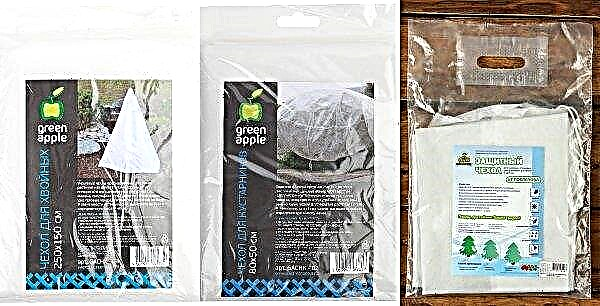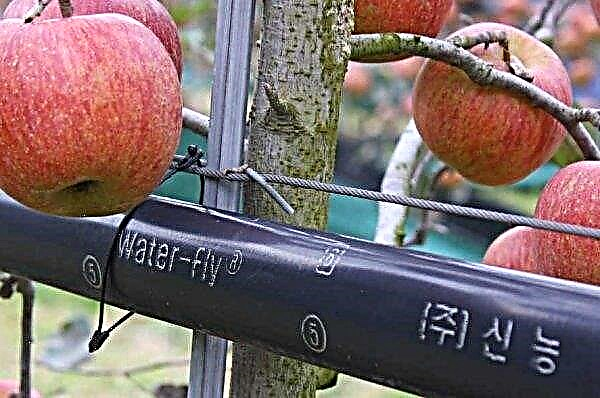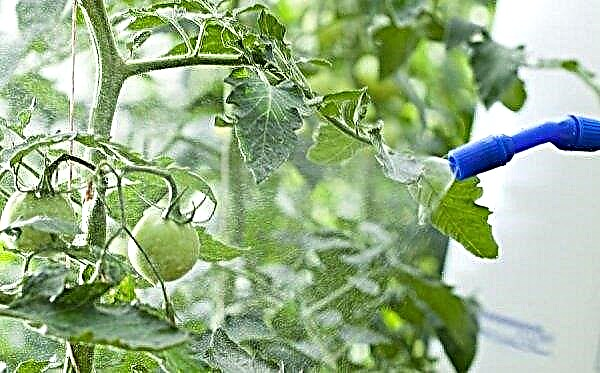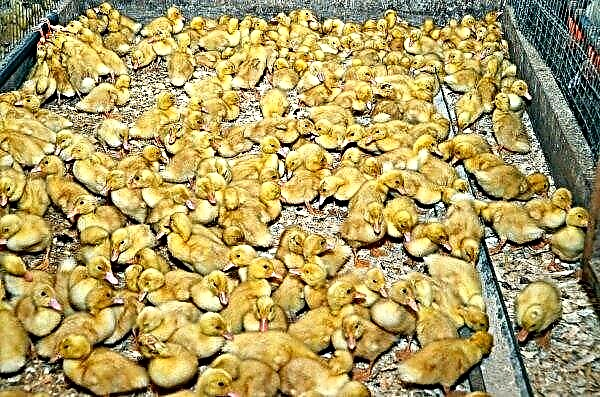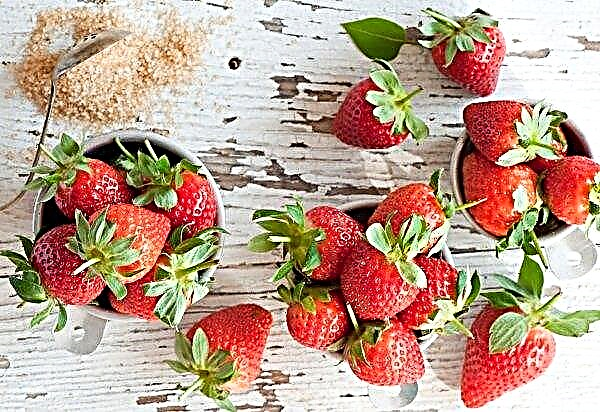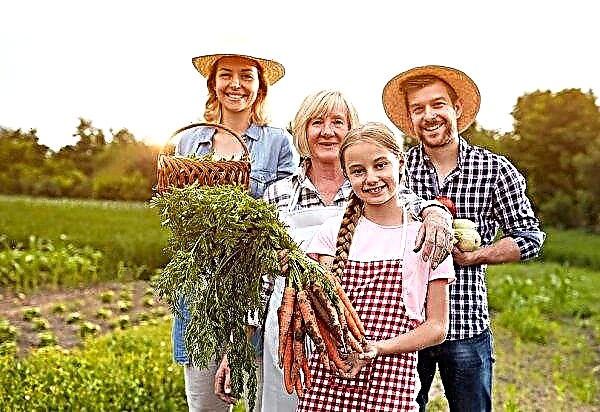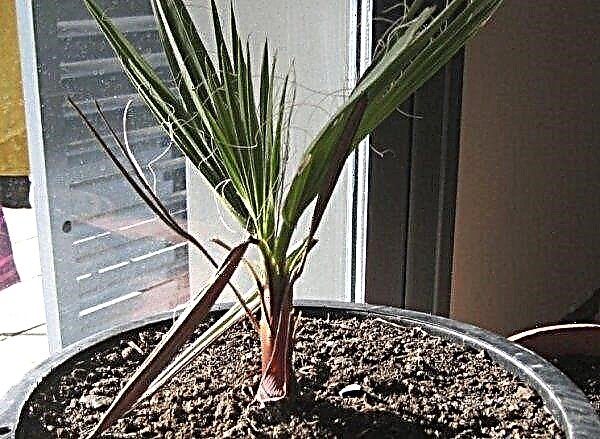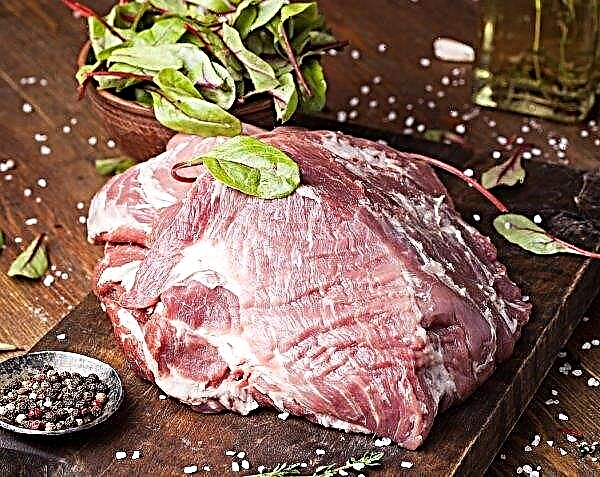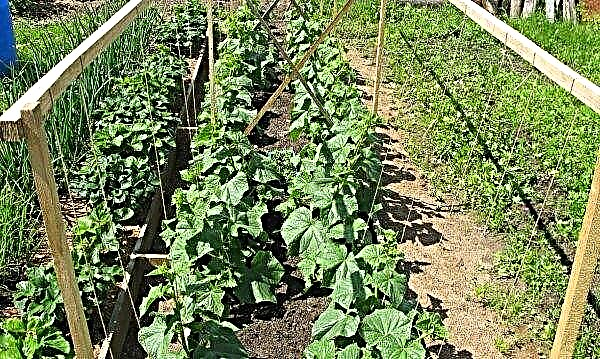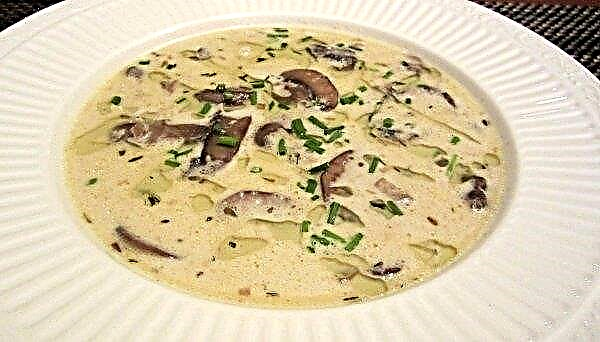Hydrangea paniculata Skyfall (Frenne) is an extremely beautiful plant, which, thanks to its abundant flowering, will be a godsend for any gardener who wants to ennoble his garden. A description of the botanical features of the variety, as well as the rules for its planting and care, can be found further in the article.
Description of grade Skyfall (Skyfall)
The Skyfall variety belongs to the panicle hydrangea (Hydrangea paniculata) species, the genus Hydrangea and belongs to the Hydrangea family. This variety is a novelty in the field of floriculture. The variety was bred in Valkenburg in the Netherlands. Its author is the botanist Guido Ruvette. Skyfall was introduced in 2018 at Plantarium.
Did you know? Hydrangea inflorescences symbolize heart affection. That is why they are often used to make wedding bouquets.
The bush has a compact densely leafy crown. The plant reaches a height of 120 cm, in diameter - 70 cm. The shoots grow vertically, painted brown. The ovate leaf plates are slightly pointed at the end. Their color is dark green.
How hydrangea skyfall blooms
The described variety is distinguished by large cone-shaped inflorescences. The flowers are large, resembling hyacinths in shape. Their petals are painted in a snowy white hue, and eventually become light pink. The flowering period begins in July and lasts until the end of September. Already for 3 years after planting, the Skyfall variety will delight the gardener with its lush inflorescences.
Landing
In order for the Skyfall shrub to develop well, and its inflorescences be large and lush, you need to choose the right place for planting and prepare the soil on the site. Also, for harmonious growth, it is important to observe the planting dates and pick a seedling. If you comply with all these rules, then the shrub will delight the grower every year with its beautiful inflorescences. On the intricacies of the procedure for planting a seedling in open ground, as well as how to choose it, read on.
Video: how to plant hydrangea
Landing time
The procedure is carried out mainly in the spring. In the period when the air warms up to a temperature of + 15 ° C, you can safely start planting seedlings. Most often in a temperate climate, this time is from mid-April to mid-May. Spring planting is suitable even for regions with cold northern climates., because in this case the hydrangeas planted in the spring will have time to take root before the winter. Autumn planting can be carried out from mid-September to mid-October.
Important! When planting hydrangeas, weather conditions should be taken into account, and if there is a risk of return frosts, it is necessary to postpone the procedure to a warmer time.
Seat and Seedling Selection
It is better to buy a hydrangea in a nursery or in a specialized flower shop. For planting in the garden choose 2-year-old seedlings, which are sold in pots. When buying planting material, it is necessary to carefully examine it for dry areas or diaper rash, because their presence indicates that the seedling is sick with a fungal infection. It is better to refuse such a purchase. It is necessary to plant a bush of the described variety in a lit or semi-shaded place. The soil on the site should be acidic, fertile, moisture permeable. Hydrangea is planted near houses or along curbs. Do not place the planting of this plant near large trees, because they will absorb all the incoming moisture.
It is better to refuse such a purchase. It is necessary to plant a bush of the described variety in a lit or semi-shaded place. The soil on the site should be acidic, fertile, moisture permeable. Hydrangea is planted near houses or along curbs. Do not place the planting of this plant near large trees, because they will absorb all the incoming moisture.
Soil preparation
The soil for planting should be prepared six months before the process. Pre-clean the area from vegetation, dig the soil to a depth of 40 cm. For each 1 m², 10 kg of peat, 10 kg of sand and 7 kg of manure are added. By the time the seedlings are planted in the soil, the soil will become more loose and moisture permeable.
Landing instruction
A day before planting a seedling in open ground, you need to dig a hole 50 cm deep and 60 cm wide. 20 liters of water are poured into it.
The upper fertile soil is left to prepare a substrate, which consists of:
- proper soil - 5 kg;
- peat - 5 kg;
- sand - 5 kg;
- superphosphate - 60 g.
Step-by-step landing instructions:
- Put a drainage layer 5 cm high on the bottom of the hole. Expanded clay or pebbles can be used as the material.
- Further, until the middle of the pit, you need to fill up the soil substrate.
- A seedling is introduced into the hole along with an earthen lump.
- Then the earth is tamped and watered with a plant of 15 liters of water.
- Mulch the soil with peat or pine needles.

Hydrangea Care
Hydrangea is a whimsical crop: it loves moisture and fertile soils. Therefore, it is important to follow the rules for caring for her. Caring for the plant consists in timely pruning, watering and feeding.
Watering
The hydrangea shrub is water-loving, therefore, it needs regular watering. During the rainy period, the plant is watered as the soil dries, the rest of the time water is added to 20-30 liters per adult plant 2-3 times a week. The fluid must be left to stand for 2 days. Also, for better development of the bush, 20 g of sulfur or 30 g of citric acid per 10 l are added to water for irrigation. Such irrigation is carried out once a month.
Top dressing
For the harmonious development of the described bush, it is necessary to carry out at least 3 top dressings annually.
Fertilizer application:
- During budding, a solution of 40 g of urea and 20 l of water is added.
- In mid-June, the plant is fed a solution of 20 g of superphosphate and 20 l of water.
- In mid-July or early August, fertilizer is carried out, consisting of 3 kg of mullein, diluted in 10 liters of water.
Video: hydrangea organic nutrition
Features of care during the flowering period
Skyfall Hydrangea begins to bloom in July. The last inflorescences appear in September. Such a long flowering period involves constant care for the bush, which is to maintain its beautiful appearance. All inflorescences that bloom should be cut so that the shrub has the opportunity to form ovaries again in their place.
Also, during the flowering period, the gardener must remove broken branches, yellowed leaves. Gardeners who have been cultivating hydrangeas for many years recommend not to carry out autumn pruning of inflorescences so that the plant's buds do not freeze in frosty weather.
Pruning
After planting a seedling in the ground for the first 3 years, only sanitary pruning of the plant is carried out. It involves the removal of all improperly growing, damaged by disease or pest shoots. When the plant reaches 4 years of age, pruning begins, which stimulates the growth of shoots and inflorescences. To do this, in the spring, cut all branches to 4 buds. From the age of 6, anti-aging pruning begins. It involves the removal of 1 to 3 lignified shoots.
When the plant reaches 4 years of age, pruning begins, which stimulates the growth of shoots and inflorescences. To do this, in the spring, cut all branches to 4 buds. From the age of 6, anti-aging pruning begins. It involves the removal of 1 to 3 lignified shoots.
Important! Pruning is carried out in dry, calm weather, it is done only with sharpened tools that have been disinfected. Compliance with such rules will allow the process of branch removal to be carried out quickly and without complications in the form of infection of the plant with a fungal infection.
Winter care
Before the winter cold, it is necessary to prepare both the site and the plant. The entire area in the garden should be cleared of the remaining debris and weed grass. On the plant, remove all leaf plates that did not have time to crumble. The soil near the trunk is mulched with peat or sawdust 8 cm in height. The procedure will help maintain optimal moisture and heat in the root system. Shrubs under 4 years old are covered with spruce for the winter. With the advent of spring, it is gradually removed so that the plant does not undergo sunburn.
Video: preparing panicle hydrangea for winter
Diseases and pests: control methods and prevention
Poor plant care can cause diseases such as chlorosis and white rot. Chlorosis manifests itself in the form of discoloration of leaf plates, which then dry out. The disease occurs due to a lack of iron in the soil due to limited watering or alkalization of the soil.
Chlorosis control:
- With a lack of iron, it is necessary to fertilize - 20 g of copper sulfate per 10 liters of water.
- If the pH of the soil is above 7.5, then it is necessary to take measures to reduce this indicator to 5.5. To do this, the trunk circle is mulched with peat or compost in the amount of 5 kg per 1 m². You can also water the plant with acidified water - 10 l of liquid 30 g of citric acid.
 White rot affects the plant in conditions of high humidity and heat. A white fluffy coating appears on the leaf blades of the shrub. The shoots of the lower tier begin to blacken and rot.
White rot affects the plant in conditions of high humidity and heat. A white fluffy coating appears on the leaf blades of the shrub. The shoots of the lower tier begin to blacken and rot.
The fight against white rot:
- Damaged shoots are cut into a ring and burned. Sections are treated with garden var or potassium permanganate solution.
- Irrigation with a solution of copper 3% (per 10 l of water 300 g of copper sulfate).
 If there is a lot of weed in the garden and there are fruit trees, hydrangea can be affected by aphids. The insect settles on the shoots and sucks the juice from the plant. Aphids are easy to spot on twisted leaf blades that have a whitish coating. Over time, plant growth slows down.
If there is a lot of weed in the garden and there are fruit trees, hydrangea can be affected by aphids. The insect settles on the shoots and sucks the juice from the plant. Aphids are easy to spot on twisted leaf blades that have a whitish coating. Over time, plant growth slows down.
The fight against aphids involves such actions:
- Manual cleaning of insects from a plant.
- Removing weed from the site.
- Spraying the shrub with a soap-ash solution - 100 g of soap, 300 g of ash and 10 l of water.
 In order that the gardener does not have problems with diseases and pests, it is necessary to carry out preventive work annually, which are:
In order that the gardener does not have problems with diseases and pests, it is necessary to carry out preventive work annually, which are:
- landing of high-quality planting material;
- timely pruning;
- cleaning the site from the remains of vegetation and weeds;
- spraying the plants during the spring thaw with a copper solution of 1% (100 g per 10 l of water);
- checking the acidity of the soil, which should not exceed 5.5.
Breeding
In order not to purchase expensive hydrangea seedlings, you can perform the process of propagation of the plant yourself.
You can get new planting material in the following ways:
- cuttings;
- layering;
- seeds.
Seeds
Hydrangea seeds can be purchased at a specialist flower shop or online. Planting material must be intact, dry, without any signs of exposure to insects or diseases. Before germination, seeds must be disinfected in a slightly pink solution of potassium permanganate. The process is carried out for 15-20 minutes, after which the planting material is placed in a humid environment. To do this, wet sand is poured into a plastic bag or plastic container with a lid and seeds are placed there for a period of about 30 days. Seeding is carried out in January or February. To do this, prepare a special substrate, which consists of peat, sand, sheet soil taken in equal parts. The mixture is poured into a container for growing and seeds are introduced to a depth of 1-2 cm at a distance of 5 cm from each other.
To do this, wet sand is poured into a plastic bag or plastic container with a lid and seeds are placed there for a period of about 30 days. Seeding is carried out in January or February. To do this, prepare a special substrate, which consists of peat, sand, sheet soil taken in equal parts. The mixture is poured into a container for growing and seeds are introduced to a depth of 1-2 cm at a distance of 5 cm from each other.
The first shoots appear in 3-4 weeks. When 2 leaflets grow on sprouts, they can be planted in single pots. Planting in the open ground can be done in 2 years, when the plant grows stronger and forms a good root system.
Cuttings
In order to propagate the plant in question with green cuttings, it will be necessary to cut young shoots in mid-June or early July. Their length should be up to 20 cm. Sprigs are cut from both sides. The upper section is carried out above the kidney, and the lower - under it. Before planting, the cuttings must be placed in a solution of the Kornevin preparation for 30 minutes to stimulate root formation. On the site, choose a place suitable for planting cuttings and dig there soil with 10 kg of peat and 10 kg of sand per 1 m² of area. After the procedure, cuttings are stuck to a depth of 2-3 cm in the soil and watered with water, 200 ml per each twig. During the first 14 days, the shoots are covered under a cover of polyethylene or plastic. After 2 weeks, the covering material is removed.
On the site, choose a place suitable for planting cuttings and dig there soil with 10 kg of peat and 10 kg of sand per 1 m² of area. After the procedure, cuttings are stuck to a depth of 2-3 cm in the soil and watered with water, 200 ml per each twig. During the first 14 days, the shoots are covered under a cover of polyethylene or plastic. After 2 weeks, the covering material is removed.
Next is the care of the cuttings, which consists of:
- watering - 200 ml per shoot;
- loosening the soil.
During the autumn cooling sprigs covered with spruce branches or burlap. With the advent of spring, the cuttings will already have a fully formed root system and they can be transplanted to a new place.
Layering
Propagation of hydrangea by layering is one of the easiest ways to quickly obtain seedlings. To do this, in the spring, choose the longest young shoot and bend it to the soil. At the bend, pinch him with a metal bracket and sprinkle with earth.
During the summer period, the shoot is spud and watered. By autumn, the layers will form the root system, but will not yet be ready for transplantation. It is covered with burlap for the winter, and with the advent of spring they are planted in a new place.
Did you know? If hydrangea is fertilized with aluminum, then it will change the color of the inflorescences to blue.
Gardeners should pay attention to the hydrangea of the Skyfall variety: the plant is distinguished by beautiful lush brooms of inflorescences and a compact crown, therefore it will perfectly complement the landscape of the park or garden.

